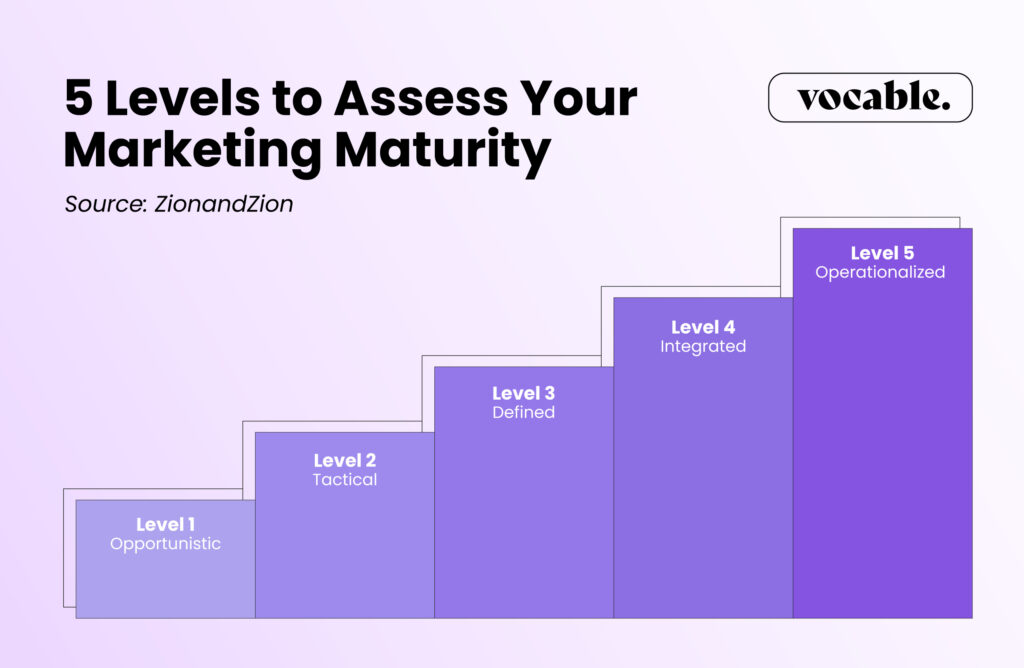Are you ready to take your marketing game to the next level?
Picture having a roadmap that can transform your marketing practices, fuel growth, and put you ahead of the competition. This is where a well-developed marketing maturity model steps in.
In today’s rapidly evolving landscape, a strategic approach to marketing is crucial—it’s about creating the right content, targeting the right audience, and delivering it at the right time. This is where the content maturity model shines.
In this comprehensive guide, we’ll delve deep into content maturity models and how they supercharge your marketing efforts. From understanding the fundamentals to implementing advanced strategies, we’ve got you covered.
Why does it matter, you ask?
The numbers speak for themselves—companies with a well-defined marketing maturity model experience 20% higher revenue growth than their competitors. We understand your challenges and have crafted this guide as your go-to resource for conquering them and developing a content maturity model that drives real results.
Get ready to embark on a journey of growth and transformation. Let’s dive in!

Understanding the Fundamentals
Let’s dive into the core concepts—the fundamentals of marketing maturity.
The content marketing maturity model is more than just a buzzword—it’s a strategic framework that enables organizations to gauge and improve their marketing effectiveness. It encompasses various elements, including strategy, processes, technology, and data analysis. Businesses can identify strengths and weaknesses by assessing their maturity level, setting goals, and aligning their marketing efforts for success.
What Is Marketing Maturity?
The concept refers to an organization’s ability to effectively plan, execute, measure, and optimize its marketing activities to achieve desired outcomes. Marketing maturity involves assessing and advancing marketing capabilities across multiple dimensions, including strategy, processes, technology, talent, and customer insights.
By adopting a marketing maturity model, businesses gain a structured framework to evaluate their current marketing practices, identify areas for improvement, and chart a path toward enhanced performance. This model helps them navigate the evolving marketing landscape, align marketing activities with business objectives, and maximize their return on investment.
Marketing maturity plays a vital role in today’s competitive landscape. It enables businesses to adapt to changing customer behaviors, leverage emerging technologies, and deliver personalized, data-driven experiences. Organizations prioritizing marketing maturity gain a competitive edge, drive revenue growth, and foster long-term customer loyalty.
What Is Content Maturity?
Let’s explore the concept of content maturity and its importance in driving marketing success.
Content maturity refers to the evolution and refinement of an organization’s content marketing practices. It involves progressing from ad-hoc content creation to a strategic and data-driven approach that aligns with business goals and audience needs.
As businesses mature in their content marketing efforts, they become more proficient in content planning, creation, distribution, and measurement.
Drawing parallels between marketing and content maturity is crucial as they are interdependent. A well-developed marketing maturity model provides the foundation for a robust content maturity model. Marketing maturity encompasses the broader strategic framework, while content maturity focuses on the specific domain of content marketing.
The correlation between marketing and content maturity is clear. A strong marketing maturity model sets the stage for effective content planning and execution. It enables businesses to align their content strategy with overall marketing objectives, target the right audience, and deliver content that resonates.
On the other hand, content maturity contributes to overall marketing maturity by ensuring the creation of high-quality, targeted content that engages and converts. As organizations advance in their content maturity, they can better leverage data insights, optimize content performance, and drive meaningful audience interactions.
Understanding the relationship between marketing and content maturity is essential for businesses aiming to thrive in the digital landscape. By developing both aspects in tandem, organizations can create a powerful synergy that drives marketing success and amplifies the impact of their content strategies.
Examples of Content Maturity Models
Now let’s explore some real-world examples of content maturity models that can guide organizations in their quest for content excellence. These models provide frameworks and benchmarks to assess and improve various aspects of content strategy, production, and performance. By understanding these examples, organizations can gain insights into proven approaches and adapt them to their own content operations for optimal results.
Kapost Content Operations Maturity Model
The Kapost Content Operations Maturity Model is a valuable framework that outlines the different stages of content operations maturity within an organization. This model consists of five stages: Reaction, Siloed, Mobilizing, Integrating, and Optimized. Each stage represents a unique level of maturity and provides insights into the behaviors and characteristics observed in organizations at that stage.
Approximately 15% of organizations fall into the Reactive stage. The Reactive stage is characterized by chaos, siloed work, ad hoc content practices, and a lack of clear strategy. In this stage, pockets of greatness exist within teams and marketing strategies, helping them stay afloat. However, content planning is often reactive and lacks a strategic approach, with ad hoc requests dominating the marketing workload.
Additionally, undefined collaboration processes and responsibilities contribute to siloed work, hindering effective communication and coordination. As a result, content lacks a clear and unifying message across all channels. Furthermore, the absence of a central location for content storage leads to wasted time searching for assets.
Content Science Maturity Model
The Content Science Maturity Model, developed by Colleen Jones in her book “The Content Advantage,” outlines a comprehensive framework consisting of five stages:
- Chaotic
- Piloting
- Scaling
- Sustaining
- Thriving
Organizations struggle with content management in the Chaotic stage, lacking a clear strategy and facing operational challenges. As they progress to the Piloting stage, they begin experimenting and testing new approaches on a smaller scale, learning from their experiences and refining their strategies accordingly.
The Scaling stage focuses on implementing successful initiatives at a larger scale, streamlining content operations, and achieving consistency across various channels. Organizations then move to the Sustaining stage, where they establish a solid foundation with standardized processes, guidelines, and governance frameworks to support their content operations.
Finally, the Thriving stage represents the pinnacle of content operations maturity. Organizations operating at this stage continuously optimize their processes, leverage advanced technologies, and deliver exceptional content experiences to their audiences. They embrace innovative decision-making and maintain a culture of continuous improvement.
Kontent by Kentico Maturity Model
Kontent by Kentico introduces a five-stage model for content operations maturity: Lagging, Starting, Progressing, Modernized, and Innovating. Each stage represents a level of maturity, ranging from falling behind to breaking out. The model visually illustrates these stages and their respective meanings. For instance, the Lagging stage suggests the need to catch up, while Progressing signifies building momentum.
While the names of the stages may differ across models, there are commonalities in the behaviors, circumstances, and challenges they represent. These models offer valuable insights for assessing content operations and serve as guiding frameworks for organizations seeking to enhance their maturity. Companies can employ these models to evaluate content operations in diverse organizations, recognizing their significance in driving success and effectiveness.
By adopting the Kontent by Kentico Maturity Model, organizations can assess their current stage and identify areas for improvement. This model encourages a progressive approach, enabling organizations to move from a state of lagging to one of innovation. With a focus on continuous growth and adaptation, organizations can optimize their content operations and achieve greater maturity, ultimately delivering exceptional content experiences and driving business success.
5 Levels to Assess Your Marketing Maturity

Now, let’s switch some gears to the five levels to assess your marketing maturity. These levels provide a valuable framework for evaluating your marketing efforts and identifying areas for improvement.
Level 1. Opportunistic
According to ZionandZion, at the Opportunistic level, organizations take a spontaneous and reactive approach to marketing. They seize immediate opportunities without a cohesive strategy, relying on ad hoc tactics and sporadic campaigns. While this approach may yield occasional wins, sustainable growth and long-term success remain elusive. To progress beyond this level, businesses must recognize the importance of developing a more structured marketing approach and aligning their efforts with broader strategic goals. This includes defining target audiences, establishing consistent messaging, and laying the groundwork for a more proactive marketing strategy.
Level 2. Tactical
The Tactical level marks a shift toward a more systematic and planned marketing approach. Organizations at this stage begin to understand their target audience better and employ tactical strategies to engage with them effectively. They leverage various marketing channels, such as social media, email campaigns, and content creation, to raise brand awareness and generate leads. However, the focus remains primarily on individual campaigns and activities, lacking a cohesive marketing strategy. To progress further, businesses must elevate their strategic thinking, align marketing initiatives with overall business objectives, and adopt an integrated approach that brings together various channels and campaigns for a more impactful marketing presence.
Level 3. Defined
The Defined level signifies a significant step forward in marketing maturity. At this stage, organizations have a well-defined marketing strategy that aligns with their business goals. They have a clear understanding of their target market, buyer personas, and positioning in the market. Marketing activities are planned and executed based on comprehensive research, data-driven insights, and a deep understanding of customer needs. This level emphasizes the importance of consistent branding, effective messaging, and targeted campaigns that resonate with the intended audience. To reach higher levels of marketing maturity, businesses must strive to refine and optimize their strategies, constantly adapting to changing market dynamics and customer preferences.
Level 4. Integrated
The Integrated level represents a more advanced stage of marketing maturity, where organizations successfully integrate various marketing channels and initiatives to deliver a cohesive and unified customer experience. They deeply understand their customers’ journey and employ marketing automation, CRM systems, and advanced analytics to streamline processes and gain actionable insights. At this level, organizations focus on personalized and targeted marketing, leveraging customer data to drive segmentation and tailor messaging accordingly. Businesses can effectively nurture leads, enhance customer engagement, and drive consistent growth by integrating marketing efforts, aligning teams, and leveraging technology.
Level 5. Operationalized
The Operationalized level represents the pinnacle of marketing maturity, where organizations have fully operationalized their marketing processes, systems, and strategies. At this stage, marketing becomes an integral part of the overall business operations, seamlessly aligning with other departments such as sales and customer service. Organizations leverage advanced marketing technologies, predictive analytics, and AI-powered solutions to optimize campaigns, automate workflows, and deliver exceptional customer experiences. This level emphasizes a data-driven approach, continuous experimentation, and agile marketing practices. By embracing innovation and staying ahead of market trends, businesses can achieve remarkable marketing performance, sustain growth, and remain competitive in a rapidly evolving landscape.

Things to Consider When Developing Content Models
When it comes to developing content models, there are several key factors to consider that can make a significant difference in the effectiveness and efficiency of your content operations. From understanding your audience and their needs to defining clear goals and establishing a scalable framework, these considerations lay the foundation for a successful content strategy.
Understanding the Purpose and Goals
When developing content models, it’s crucial to have a clear understanding of your purpose and goals. Start by defining the primary objective of your content strategy—is it to generate brand awareness, educate your audience, or drive conversions? By aligning your content with specific goals, you can ensure that every piece of content serves a purpose and contributes to your overall strategy. Additionally, consider the needs and preferences of your target audience to tailor your content accordingly. A deep understanding of your purpose and goals will guide you in creating content that resonates with your audience and achieves the desired outcomes.
Mapping Content to Buyer’s Journey
To create effective content models, it’s essential to map your content to the buyer’s journey. Understand the stages your audience goes through, from awareness to consideration and decision-making, and develop content that addresses their needs at each stage. This strategic approach ensures that you deliver the right content to the right people at the right time. Begin by identifying the key touchpoints and questions that arise during each stage. Then, craft content that educates, guides, and influences your audience along their journey. By mapping your content to the buyer’s journey, you can create a seamless experience that nurtures prospects and drives them closer to conversion.
Using Tools and Specialized Platforms
When it comes to developing content maturity, utilizing tools and specialized platforms can significantly enhance your workflow and efficiency. One such platform that stands out is Vocable. It serves as a reliable and go-to solution for streamlining all aspects of content maturity development.

Vocable offers a comprehensive set of features that support the entire content lifecycle. From ideation to creation and team collaboration, Vocable provides a seamless experience. Its intuitive interface allows you to brainstorm ideas, organize content calendars, and manage tasks effortlessly. With Vocable’s robust collaboration tools, teams can collaborate in real time, ensuring everyone stays on the same page and deadlines are met.

What sets Vocable apart is its focus on content maturity. It provides valuable insights and analytics to measure the effectiveness of your content, enabling you to make data-driven decisions and optimize your strategies. The platform also integrates with various content management systems and marketing tools, simplifying the content publishing and distribution process.

Utilizing the features of Vocable enables you to enhance the development of your content maturity in a more efficient and effective manner, optimizing the results of your content efforts. Regardless of whether you work individually or as part of a sizable marketing team, Vocable empowers you to elevate your content strategy and attain heightened levels of marketing success.
Leveraging Data and Analytics for Insights
Leveraging data and analytics is crucial in content development. By analyzing data, you gain valuable insights into your audience’s preferences, behaviors, and content consumption patterns. This information allows you to create targeted, relevant, and personalized content that truly connects with your audience. By utilizing data analysis tools and platforms, you can access comprehensive data and analytics features to track performance metrics, uncover trends, and make data-driven decisions. Harnessing the power of data empowers you to optimize your content strategy and deliver impactful experiences.
Monitoring and Optimizing Content Performance
Monitoring and optimizing content performance is essential for ensuring your content resonates with your audience and achieves its intended objectives. By keeping a close eye on key performance indicators (KPIs) such as engagement metrics, conversion rates, and audience feedback, you can gain access to a wealth of valuable information about how your content is performing. This data allows you to identify areas for improvement, make data-backed adjustments, and deliver better experiences. By continuously monitoring and optimizing your content, you can refine your approach, maximize the effectiveness of your content, and drive meaningful results.
Final Words
In conclusion, developing effective content models requires considering key factors like understanding goals, mapping content to the buyer’s journey, leveraging data and analytics for insights, and monitoring content performance.
To streamline the process, consider using Vocable—a comprehensive platform that enables seamless content ideation, creation, and team collaboration. With Vocable, you can enhance workflows, boost productivity, and ensure content quality. Whether you’re a content creator, marketer, or part of a content team, Vocable is the go-to platform for taking your content maturity to the next level.
Unlock the full potential of your content strategy by visiting Vocable today.



